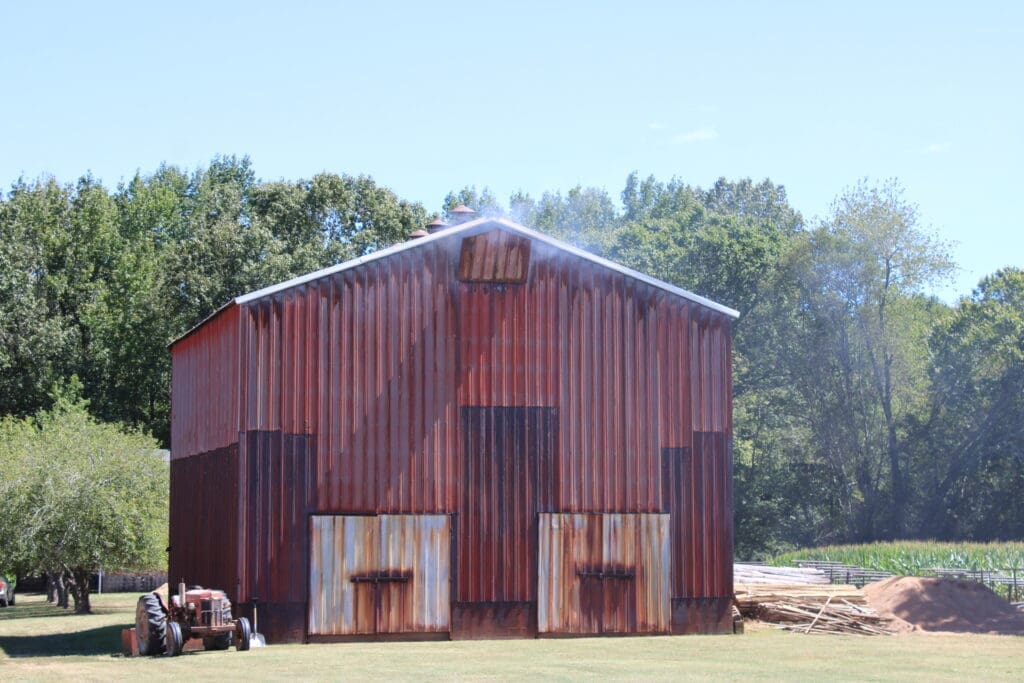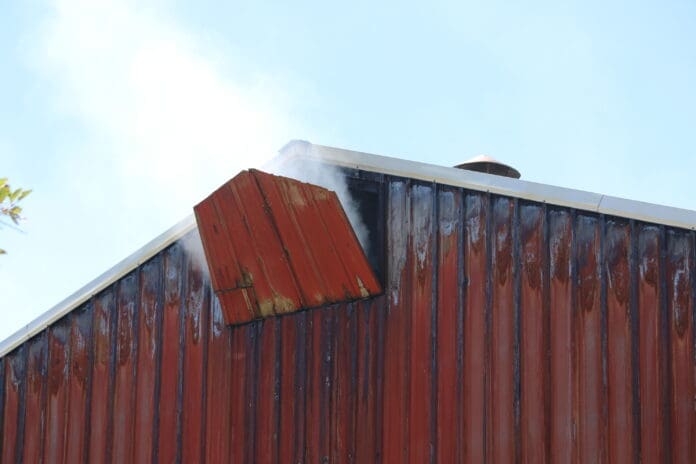MURRAY – The curing season for dark-fired tobacco runs from late-August through September, and while western Kentucky residents may be used to seeing smoke billowing from the vents of tobacco barns at this time of year, those who are not accustomed to such sights oftentimes think the building is on fire.
“We get a lot of people from the north and the west that come in and visit our county, which is absolutely great,” said Calloway County 911 Communications Center Director Nathan Baird. “However, they don’t know what a tobacco barn is. So, they see one, and they call 911, which is fine to an extent; but we get about several calls a year that there’s a barn on fire, and it’s not. It’s smoking and doing what it’s supposed to do, but people think that it is on fire.”

To help mitigate problems caused by people making unnecessary reports, the dispatch center has started a tobacco barn registry. Although it is not required, barn owners and renters are encouraged to visit the Calloway County Sheriff’s Office and fill out a registration form that asks for their contact information as well as details about the barn(s).
“If people call in and say there’s a barn on fire, we’d like to know whether it is ‘your’ barn or a tobacco barn because there’s quite a bit of difference between the two,” Baird said. “Like your barn or garage would probably have chemicals, stuff like that. A tobacco barn has tobacco in it, could be wood or metal; they’re going to burn pretty quick.”

Dispatcher Fiona Branham, a former Calloway County Fire-Rescue (CCFR) volunteer who has worked in the communications center for three years, came up with the idea.
“I actually started out on fire-rescue as a firefighter,” she said. “So, I knew a little bit about tobacco barns and the struggle the fire department goes through, running all over the place for them and showing up and it’s nothing. So, I wanted to try and make it a little bit easier on the dispatch center, the fire department and tobacco farmers.”
Branham started informally collecting the contact information of tobacco barn owners and/or renters last year. Her goal is to use the information obtained to develop a map with pins identifying every registered tobacco barn in Calloway County.

“So, when we get a call about a tobacco barn, we can click on that pin on the map, and it will show the owner’s name and phone number and the address where (the barn) is at,” she explained. “It will show how many barns are there, what kind of barn it is, all kinds of different details that help us better dispatch, to figure out what to take – for the fire department to bring – there to put out the fire and help the fire department know what they’re getting to before they get there.”
“With all of these,” Branham clarified, “I would dispatch the fire department anytime I receive a call, but it’s something where if we find out that the barn functioning normally, we can cancel them in route instead of having to go all the way out there. Some of these barns are pretty far out.”

Not only will the registry help CCFR and the dispatch center, but it will help the farmers, too.
“Sometimes we get tobacco barns that are on fire,” Baird noted, “and people call in; we get out there and put out the fire, but no one knows who owns the tobacco barn. We can’t tell anybody that their tobacco barn caught fire.”


Baird also noted there are a few barns in the county with which dispatchers and CCFR are very familiar. For example, the dispatch center receives five or six calls every year about the barns located on KY 2547 S (formerly known as U.S. 641 S), near Midway.
Terry Orr is the owner of those tobacco barns, three in total. His family has been growing tobacco in the area since 1825. The seventh-generation tobacco farmer has been in the business for 55 years, learning the process from his grandfather and father.
The process of curing tobacco, whether it be fire- or air-cured, really starts in the field where plants are cut and hung on poles, six plants per pole, before loading them on a scaffold wagon, which carries the plants from the field to a barn for curing. The plants currently curing in Orr’s barns will be used to make chewing tobacco.

For dark-fired tobacco, five layers of poled tobacco are hung in the barn. Farmers lay down slabs of hardwood – oak and hickory are preferred – in rows running the length of the barn, with a few small gaps along the way. The slabs are then covered with mounds of sawdust and set on fire.

The plants stay in the barn for four to five weeks. In that time, the green plants will slowly turn yellow, then brown. At all points, fire is required, Orr explained; however, the temperatures necessary to achieve the desired results vary widely depending on where the plants are along that continuum.
“The heat comes from how many slabs you put there,” he said. “You put three or four; if you do five, it’ll get hotter. If you just put two, it will (be cooler). You just kind of learn that from knowing what it needs.”

While the leaves are green or yellow, low heat and adequate ventilation prevent the tobacco from rotting. Orr said that when the leaves turn brown, then it is time to crank up the heat (ideally to 130 degrees) to dry out the plants’ stems.
“(When the) weather is really dry – low humidity and all of that – it doesn’t take much,” he explained. “If it was rainy weather and cold, you’d have to have more wood in there to warm it up. People get them up to 180 degrees and burn them up. They just keep adding wood. Maybe it’s somebody that’s new at it or somebody that’s not new at it but (in a hurry).”

Luckily, Orr has never had a barn catch on fire.
“We go in about every five, six hours and have a look,” he said. “Something could’ve fell. I could walk around and maybe a plant fell out; if I found it, I can pick it up. But if it fell out during the night and nobody’s out here watching it, then it might just blaze up. When sparks get up here and start touching this tobacco… you can’t check it often enough. I have caught stuff – a plant fell down – and I picked it up and saved it.”
Orr said that the time to worry about a tobacco barn is if the smoke is black, “If I came out and it was just that black smoke rolling out like the corner of a house, once you open the door, you’ve got air in there. But it’s too late anyway.”
The dispatch center asks that, if you see a barn that is believed to be on fire and are unfamiliar with the process, please refrain from opening the doors and contact the dispatch center at the non-emergency number, 270-753-3151.





Such a great article! I grew up on a tobacco farm and can attest to the statement that it’s a dying breed. There really is an art to firing it and this explained it perfectly for people unfamiliar with the process.
Thank you, Anne!
Great article…and timely!!
Thank you, Vicki!